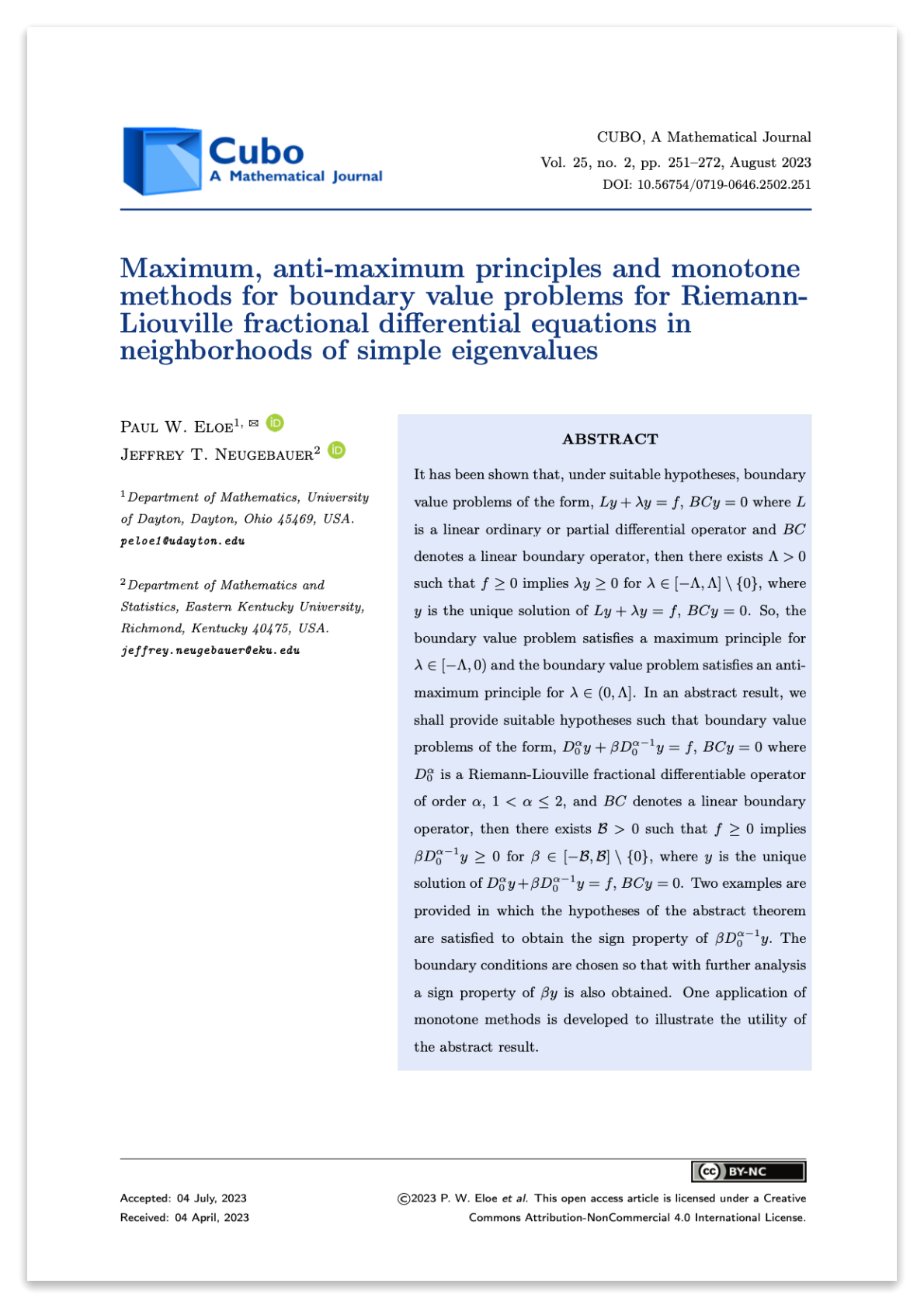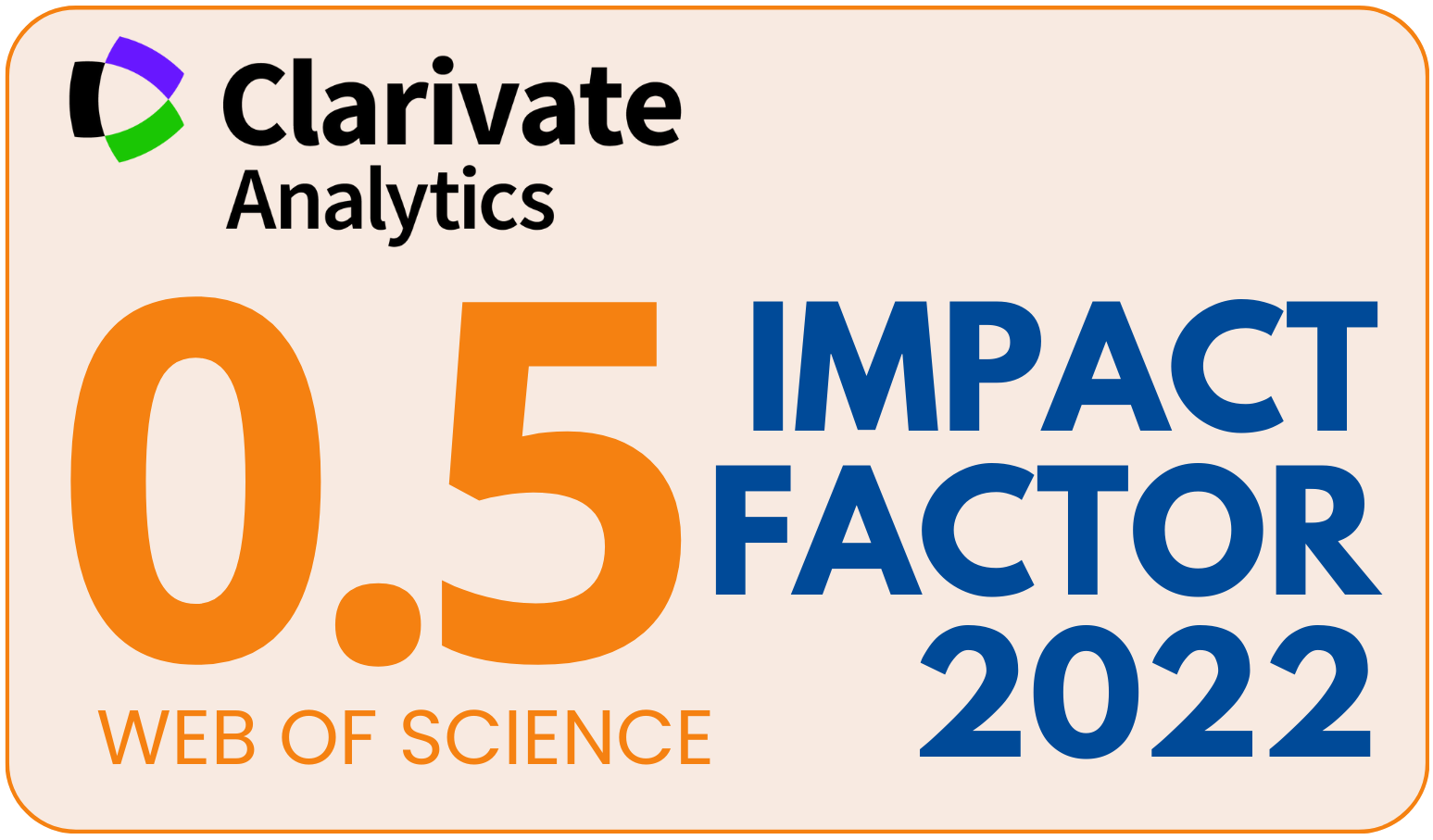Maximum, anti-maximum principles and monotone methods for boundary value problems for Riemann-Liouville fractional differential equations in neighborhoods of simple eigenvalues
-
Paul W. Eloe
 peloe1@udayton.edu
peloe1@udayton.edu
-
Jeffrey T. Neugebauer
 jeffrey.neugebauer@eku.edu
jeffrey.neugebauer@eku.edu
Downloads
DOI:
https://doi.org/10.56754/0719-0646.2502.251Abstract
It has been shown that, under suitable hypotheses, boundary value problems of the form, \(Ly+\lambda y=f,\) \(BC y =0\) where \(L\) is a linear ordinary or partial differential operator and \(BC\) denotes a linear boundary operator, then there exists \(\Lambda >0\) such that \(f\ge 0\) implies \(\lambda y \ge 0\) for \(\lambda\in [-\Lambda ,\Lambda ]\setminus\{0\},\) where \(y\) is the unique solution of \(Ly+\lambda y=f,\) \(BC y =0\). So, the boundary value problem satisfies a maximum principle for \(\lambda\in [-\Lambda ,0)\) and the boundary value problem satisfies an anti-maximum principle for \(\lambda\in (0, \Lambda ]\). In an abstract result, we shall provide suitable hypotheses such that boundary value problems of the form, \(D_{0}^{\alpha}y+\beta D_{0}^{\alpha -1}y=f,\) \(BC y =0\) where \(D_{0}^{\alpha}\) is a Riemann-Liouville fractional differentiable operator of order \(\alpha\), \(1<\alpha \le 2\), and \(BC\) denotes a linear boundary operator, then there exists \(\mathcal{B} >0\) such that \(f\ge 0\) implies \(\beta D_{0}^{\alpha -1}y \ge 0\) for \(\beta \in [-\mathcal{B} ,\mathcal{B} ]\setminus\{0\},\) where \(y\) is the unique solution of \(D_{0}^{\alpha}y+\beta D_{0}^{\alpha -1}y =f,\) \(BC y =0\). Two examples are provided in which the hypotheses of the abstract theorem are satisfied to obtain the sign property of \(\beta D_{0}^{\alpha -1}y.\) The boundary conditions are chosen so that with further analysis a sign property of \(\beta y\) is also obtained. One application of monotone methods is developed to illustrate the utility of the abstract result.
Keywords
Mathematics Subject Classification:
B. Alziary, J. Fleckinger and P. Takáč, “An extension of maximum and anti-maximum principles to a Schrödinger equation in Rn, J. Differential Equations, vol. 156, no. 1, pp. 122–152, 1999. DOI: https://doi.org/10.1006/jdeq.1998.3609.
D. Arcoya and J. L. Gámez, “Bifurcation theory and related problems: anti-maximum principle and resonance”, Comm. Partial Differential Equations, vol. 26, no. 9–10, pp. 1879–1911, 2001. DOI: https://doi.org/10.1081/PDE-100107462.
Z. Bai and H. Lü, “Positive solutions for boundary value problem of nonlinear fractional differential equation”, J. Math. Anal. Appl., vol. 311, no. 2, pp. 495–505, 2015. DOI: https://doi.org/10.1016/j.jmaa.2005.02.052.
I. V. Barteneva, A. Cabada and A. O. Ignatyev, “Maximum and anti-maximum principles for the general operator of second order with variable coefficients”, Appl. Math. Comput., vol. 134, no. 1, pp. 173–184, 2003. DOI: https://doi.org/10.1016/S0096-3003(01)00280-6.
A. Cabada and J. Á. Cid, “On comparison principles for the periodic Hill’s equation”, J. Lond. Math. Soc. (2), vol. 86, no. 1, pp. 272–290, 2012. DOI: https://doi.org/10.1112/jlms/jds001.
A. Cabada, J. Á Cid and L. López-Somoza, Maximum Principles for the Hill’s Equation. London, England: Academic Press, 2018.
A. Cabada, J. Á Cid and M. Tvrdý, “A generalized anti-maximum principle for the periodic on-dimensional p−Lapacian with sign changing potential”, Nonlinear Anal., vol. 72, no. 7-8, pp. 3436–3446, 2010. DOI: doi.org/10.1016/j.na.2009.12.028.
J. Campos, J. Mawhin and R. Ortega, “Maximum principles around an eigenvalue with constant eigenfunctions”, Commun. Contemp. Math., vol. 10, no. 6, pp. 1243–1259, 2008. DOI: https://doi.org/10.1142/S021919970800323X
Ph. Clément and L. A. Peletier, “An anti-maximum principle for second-order elliptic operators”, J. Differential Equations, vol. 34, no. 2, pp. 218–229, 1979. DOI: https://doi.org/10.1016/0022-0396(79)90006-8.
Ph. Clément and G. Sweers, “Uniform anti-maximum principles”, J. Differential Equations, vol. 164, no. 1, pp. 118–154, 2000. DOI: https://doi.org/10.1006/jdeq.1999.3745.
K. Diethelm, The analysis of fractional differential equations. Berlin, Germany: Springer- Verlag, 2010. DOI: https://doi.org/10.1007/978-3-642-14574-2.
P. Eloe and J. Jonnalagadda, “Quasilinearization applied to boundary value problems at res- onance for Riemann-Liouville fractional differential equations”, Discrete Contin. Dyn. Syst. Ser. S, vol. 13, no. 10, pp. 2719–2734, 2020. DOI: https://doi.org/10.3934/dcdss.2020220.
P. Eloe and J. Neugebauer, “Maximum and anti-maximum principles for boundary value problems for ordinary differential equations in neighborhoods of simple eigenvalues”, Nonlinear Dyn. Syst. Theory, in press.
P. Hess, “An antimaximum principle for linear elliptic equations with an indefinite weight function”, J. Differential Equations, vol. 41, no. 3, pp. 369–374, 1981. DOI: https://doi.org/10.1016/0022-0396(81)90044-9.
G. Infante, P. Pietramala and F. A. F. Tojo, “Nontrivial solutions of local and nonlocal Neumann boundary value problems”, Proc. Roy. Soc. Edinburgh Sect. A, vol. 146, no. 2, pp. 337–369, 2016. DOI: https://doi.org/10.1017/S0308210515000499.
A. A. Kilbas, H. M. Srivastava and J. J. Trujillo, Theory and Applications of Fractional Differential Equations. Amsterdam, Netherlands: Elsevier Science B.V., 2006.
J. Mawhin, “Partial differential equations also have principles: maximum and antimaximum” in Nonlinear elliptic partial differential equations, Providence, RI, USA: American Mathematical Society, 2009, pp. 1–13. DOI: https://doi.org/10.1090/conm/540/10655.
Y. Pinchover, “Maximum and anti-maximum principles and eigenfunctions estimates via perturbation theory of positive solutions of elliptic equations”, Math. Ann., vol. 314, no. 3, pp. 555–590, 1999. DOI: https://doi.org/10.1007/s002080050307.
M. H. Protter and H. Weinberger, Maximum Principles in Differential Equations. Englewoods Cliffs, NJ, USA: Prentice-Hall, Inc., 1967.
S. G. Samko, A. A. Kilbas and O. I. Marichev, Fractional Integrals and Derivatives: Theory and Applications. Yverdon, Switzerland: Gordon and Breach Science Publishers, 1993.
P. Takáč, “An abstract form of maximum and anti-maximum principles of Hopf’s type”, J. Math. Anal. Appl., vol. 201, no. 2, pp. 339–364, 1996. DOI: https://doi.org/10.1006/jmaa.1996.0259.
M. Zhang, “Optimal conditions for maximum and antimaximum principles of the periodic solution problem”, Bound. Value Probl., vol. 2010, Art. ID 410986, 2010. DOI: https://doi.org/10.1155/2010/410986.
J. R. L. Webb, “Initial value problems for Caputo fractional equations with singular nonlinearities”, Electron. J. Differential Equations, vol. 2019, no. 117, pp. 1–32, 2019.
S. Q. Zhang, “The existence of a positive solution for a nonlinear fractional differential equation”, J. Math. Anal. Appl., vol. 252, no. 2, pp. 804–812, 2000. DOI: https://doi.org/10.1006/jmaa.2000.7123.
Most read articles by the same author(s)
- Paul W. Eloe, Positive Operators and Maximum Principles for Ordinary Differential Equations , CUBO, A Mathematical Journal: Vol. 7 No. 2 (2005): CUBO, A Mathematical Journal
Downloads
Published
How to Cite
Issue
Section
License
Copyright (c) 2023 P. W. Eloe et al.

This work is licensed under a Creative Commons Attribution-NonCommercial 4.0 International License.














